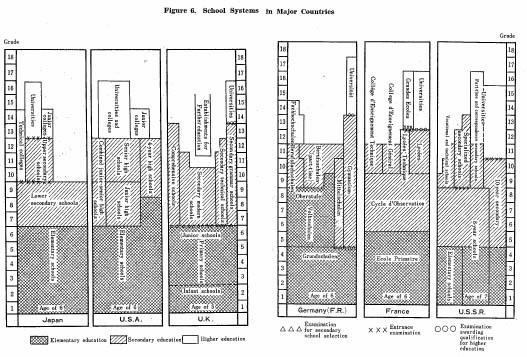| Home > Policy > White Paper, Notice, Announcement > White Paper > EDUCATIONAL STANDARDS IN JAPAN 1965 > CHAPTER |
||
After World War ![]() , the Japanese school system was changed into
a new "single-track" system organized on a 63-3 basis. This aimed to provide
equal opportunity for education for all people in order to realize the democratic
ideal of education. The new system has been modified in rare subsequent years.
In 1962, a new institution, the 5-year technical college was established. Again,
in 1964, the junior college, which had been established on an experimental basis,
was made permanent. The former is intended to provide a consistent technical
education of five years. The latter has played an important role in giving higher
education of a practical nature primarily for women.
, the Japanese school system was changed into
a new "single-track" system organized on a 63-3 basis. This aimed to provide
equal opportunity for education for all people in order to realize the democratic
ideal of education. The new system has been modified in rare subsequent years.
In 1962, a new institution, the 5-year technical college was established. Again,
in 1964, the junior college, which had been established on an experimental basis,
was made permanent. The former is intended to provide a consistent technical
education of five years. The latter has played an important role in giving higher
education of a practical nature primarily for women.
In the United States, the structure of education differs from area to area. Three structural patterns below the college level are in common use: the 6-3-3 plan, the 6-6 plan and the 84 plan. The first plan means that the pupils spend 6 years in the elementary school, 3 years in the junior high school, and 3 years in the senior high school. The present Japanese structure was based on this plan. The 6-6 plan means that pupils spend 6 years in the elementary school and 6 years in the junior-senior high school. The third pattern means that the pupils spend 8 years in the elementary school and 4 years in the high school. In the case of the publicly con-trotted schools, there are no entrance examinations during the twelve years.
Comprehensive high schools providing academic, vocational, and technical education in the same school are the most common. Large city school systems tend to specialize the high schools, providing separate schools for vocational and technical programs. But all the students completing a secondary school program terminating with the 12th grade can be admitted to an institution of higher education.
In European countries; 011 the other hand, pupils are allocated to the different schools at the age of ten or eleven. In England and Wales, pupils are allocated to the different types of schoo1 with different orientations on the basis of examinations. In the Federal Republic of Germany, pupils are divided by examination into two groups, those who can proceed to secondary schools and the others who will continue their elementary school education through the eighth, or ninth grade. In France, pupils are also directed into different secondary schools on the basis of the results obtained in an observation period. In those three countries, admission to an institution of higher education is open only to those who were admitted to and completed the academic secondary schools. (Secondary grammar schools in England and Wales, Lycee in France, and Gymnasium in the Federal Republic of Germany). In recent years, however, new secondary schools systems are being developed in order to postpone the time of differentiation, or to group pupils in a more appropriate manner. For example, in England and Wales, comprehensive secondary schools are increasing in number in London and also in some other areas. In France, colleges d'enseignement secondaire, also comprehensive secondary schools, were established in 1963.
The structure of education in the U.S.S.R. is different than in the United States of America and in European countries. There are four types of educational institutions beyond the compulsory level; i.e., the 9th and 10th grade of the 10-year school, part-time and correspondence secondary schools, technicums and other specialized secondary schools, and vocational-technical schools. Only the technicums and other specialized secondary schools have an entrance examination. According to the principle that education be connected directly with productive labor, the graduates of a part-time and correspondence secondary school who have worked their way through school are admitted to the institution of higher education in preference to the graduates of other institutions. The 10-year school was formerly an 11-year school, but the length of the schooling was shortened by one year starting with the students completing 8-year compulsory education in September 1964 as a result of the reduction in hours allocated to labor education.

| Back to Top | MEXT HOME |